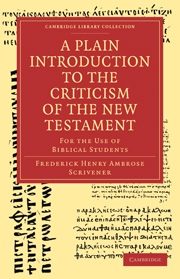Book contents
- Frontmatter
- ADVERTISEMENT
- ADDENDA ET CORRIGENDA
- Contents
- CHAPTER I PRELIMINARY CONSIDERATIONS
- CHAPTER II ON THE GREEK MANUSCRIPTS OF THE NEW TESTAMENT
- CHAPTER III ON THE ANCIENT VERSIONS OF THE NEW TESTAMENT IN VARIOUS LANGUAGES
- CHAPTER IV ON THE CITATIONS FROM THE GREEK NEW TESTAMENT MADE BY EARLY ECCLESIASTICAL WRITERS
- CHAPTER V ON THE EARLY PRINTED, AND LATER CRITICAL EDITIONS OF THE GREEK NEW TESTAMENT
- CHAPTER VI ON THE LAWS OF INTERNAL EVIDENCE, AND THE LIMITS OF THEIR LEGITIMATE USE
- CHAPTER VII ON THE HISTORY OF THE TEXT, INCLUDING A DISCUSSION OF RECENT VIEWS OF COMPARATIVE CRITICISM
- CHAPTER VIII ON THE PECULIAR CHARACTER AND GRAMMATICAL FORM OF THE DIALECT OF THE NEW TESTAMENT
- CHAPTER IX APPLICATION OF THE FOREGOING MATERIALS AND PRINCIPLES TO THE CRITICISM OF SELECT PASSAGES OF THE N. T.
- INDEX I
- INDEX II
- INDEX III
- Plate section
CHAPTER VII - ON THE HISTORY OF THE TEXT, INCLUDING A DISCUSSION OF RECENT VIEWS OF COMPARATIVE CRITICISM
Published online by Cambridge University Press: 05 August 2011
- Frontmatter
- ADVERTISEMENT
- ADDENDA ET CORRIGENDA
- Contents
- CHAPTER I PRELIMINARY CONSIDERATIONS
- CHAPTER II ON THE GREEK MANUSCRIPTS OF THE NEW TESTAMENT
- CHAPTER III ON THE ANCIENT VERSIONS OF THE NEW TESTAMENT IN VARIOUS LANGUAGES
- CHAPTER IV ON THE CITATIONS FROM THE GREEK NEW TESTAMENT MADE BY EARLY ECCLESIASTICAL WRITERS
- CHAPTER V ON THE EARLY PRINTED, AND LATER CRITICAL EDITIONS OF THE GREEK NEW TESTAMENT
- CHAPTER VI ON THE LAWS OF INTERNAL EVIDENCE, AND THE LIMITS OF THEIR LEGITIMATE USE
- CHAPTER VII ON THE HISTORY OF THE TEXT, INCLUDING A DISCUSSION OF RECENT VIEWS OF COMPARATIVE CRITICISM
- CHAPTER VIII ON THE PECULIAR CHARACTER AND GRAMMATICAL FORM OF THE DIALECT OF THE NEW TESTAMENT
- CHAPTER IX APPLICATION OF THE FOREGOING MATERIALS AND PRINCIPLES TO THE CRITICISM OF SELECT PASSAGES OF THE N. T.
- INDEX I
- INDEX II
- INDEX III
- Plate section
Summary
AN adequate discussion of the subject of the present Chapter would need a treatise by itself, and has been the single theme of several elaborate works. We shall here limit ourselves to the examination of those more prominent topics, a clear understanding of which is essential for the establishment of trustworthy principles in the application of external evidence to the correction of the text of the New Testament. The use of internal evidence has been sufficiently considered in the preceding Chapter.
1. It was stated at the commencement of this volume that the autographs of the sacred writers “perished utterly in the very infancy of Christian history” (p. 2): nor can any other conclusion be safely drawn from the general silence of the earliest Fathers, and from their constant habit of appealing to “ancient and approved copies,” when a reference to the originals, if extant, would have put an end to all controversy on the subject of various readings. Dismissing one passage in the genuine Epistles of Ignatius (d. 107), which has no real connexion with the matter, the only allusion to the autographs of Scripture met with in the primitive ages is the well-known declaration of Tertullian (fl. 200). “Percurre Ecclesias Apostolicas, apud quas ipsae adhuc Cathedrae Apostolorum suis locis praesident, apud quas ipsae Authenticae Literae eorum recitantur, sonantes vocem, et repraesentantes faciem uniuscujusque. Proximè est tibi Achaia, habes Corinthum. Si non longè es a Macedoniâ, habes Philippos, habes Thessalonicenses. Si potes in Asiam tendere, habes Ephesum. Si autem Italiae adjaces, habes Romam...” (De Praescriptions Haereticorum, c. 36).
- Type
- Chapter
- Information
- A Plain Introduction to the Criticism of the New TestamentFor the Use of Biblical Students, pp. 379 - 411Publisher: Cambridge University PressPrint publication year: 2010First published in: 1861

